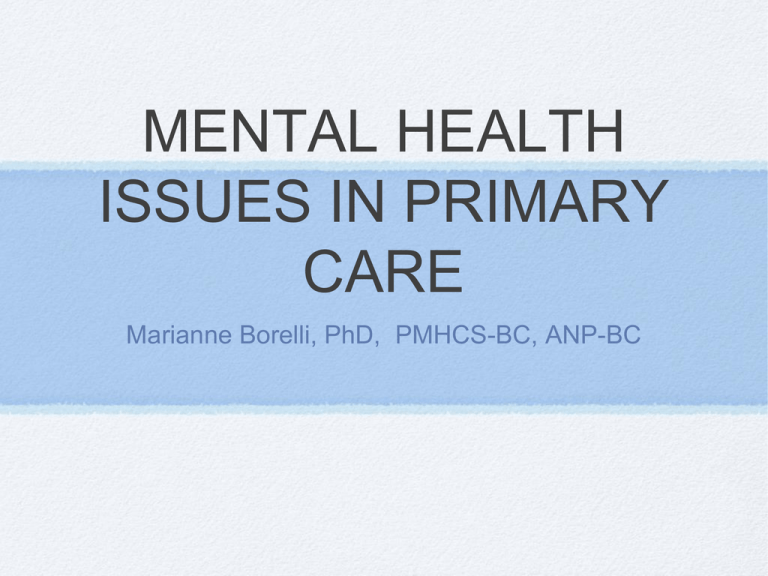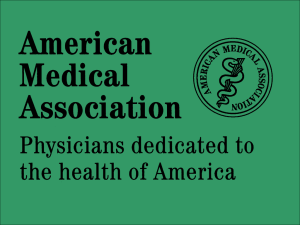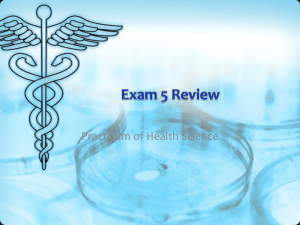MENTAL HEALTH ISSUES IN PRIMARY CARE
advertisement

MENTAL HEALTH ISSUES IN PRIMARY CARE Marianne Borelli, PhD, PMHCS-BC, ANP-BC Common Problems in Mental Health Care • Chest pain, abdominal pain, back pain • Fatigue, dizziness, swelling • Insomnia, shortness of breath, headache • Many mental health problems present as physical symptoms Relevant Questions What should I be looking for? Why is this patient seeking treatment now? What questions should I ask? Then what do I do? How do I follow-up? Where are the resources? How do I collaborate? Linda Linda, 25 yo female, came to primary care with concerns about feeling fatigued, having difficulty concentrating, insomnia, and anxiety. She has no hx of treatment for depression, anxiety, or ADHD. She has been tx for irritable bowel syndrome and asthma. She is concerned that her performance review will not be reflective of her abilities because she has such trouble concentrating and fatigue.Your learn she has a family hx of depression. Linda What history would be important to get from her? What would you assess for? What PE would be important? What labs? How would you treat on the initial visit? What screening tools would be useful? Common Presentations in Primary Care Depression, anxiety, insomnia, fatigue are frequent complaints in primary care Depression and anxiety frequently present as somatic symptoms Headaches, neck and back aches, insomnia, little energy, are often symptoms presented Hypothyroidism, anemia, adrenal fatigue, vitamin B or D deficiencies need to be R/O Assessment Time spent taking a history is time well spent First episode, family history, recent loss, substance use, other medical conditions, previous treatment successes and failures, family history of response to medications Use standardized screening tool for depression as PHQ9 or Beck Depression Inventory, and the GAD7 for anxiety Assess for anxiety, depression, and insomnia Ask about substance use Dysthymia Depressed mood for most of the day, for more days than not, for at least 2 years(DSM-IV-TR) Has not been without the symptoms for more than 2 months at a time. Presence of 2 or more of the following: poor appetite or overeating, insomnia or hypersomnia, low energy or fatigue, low selfesteem, poor concentration, difficulty making decisions, feelings of hopelessness Depression FIVE OF THE FOLLOWING SYMPTOMS DURING THE SAME 2 WEEK PERIOD AND THIS MUST BE A CHANGE FROM PREVIOUS FUNCTIONING Depressed mood most of the day, nearly every day Little interest or pleasure in all or almost all activities One of the 2 symptoms above must be present Depression Criteria Significant weight loss or weight gain, change in appetite Insomnia or hypersomnia nearly every day Psychomotor agitation or retardation Fatigue or loss of energy Feelings of worthlessness or guilt Depression Criteria Continued Diminished ability to concentrate or indecisiveness nearly every day Recurrent thoughts of death, recurring suicidal ideation w/wo plan or previous attempt Symptoms not due to a medical condition, substance use or withdrawal, or bereavement Manic Episode A distinct period of elevated, expansive or irritable mood lasting at least 1 week with 3 or more of the following present: Inflated self-esteem, decreased need for sleep, pressure to keep talking, flight of ideas, distractibility, excessive involvement in pleasurable activities that have high potential for negative consequences, psychomotor agitation. Clinical Tips Ask how these symptoms are affecting life Ask about supplements, OTC medications, and previous psychiatric medications Realize this will take time, schedule another visit Clinical Tips • Develop a relationship with the patient • Explore losses, stressors, changes in family or work situations • Assess support systems, e.g. friends, church community • Ask about family history of depression, anxiety or other mental health issues Relevant Labs To R/O a physical cause for depression, anxiety, or insomnia TSH, free T3, freeT4, CBC, CMP Vit B12, vit D, Sleep study if long standing insomnia Medication Management Second generation antidepressants to treat SSRIs(prozac, zoloft, celexa, lexapro), SNRIs(effexor, cymbalta), NDRI(wellbutrin). Avoid benzodiazepines except for short term anxiety management; e.g. treat panic attacks Trazodone preferred for insomnia over drugs that are more likely to be addictive Depression Treatment Educate pt. about time for medication to take effect, expected SE, timing of doses SSRIs effective for anxiety and depression, but benzodiazepines may be needed at first for anxiety management, especially with panic attacks Will need to be on med for 9-12 months to treat depression. A common mistake is to quit when starts to feel better Behavioral Changes Set small, achievable goals, e.g., walk 15 min every day, decrease use of caffeine, decrease use of alcohol, call a friend, family member, do one nice thing for self daily Encourage therapy-Cognitive Behavioral Therapy most effective Consider a 12 step program Use rating scales initially and at each visit to evaluate progress Follow Up F/U 2-4 weeks after starting a medication For moderate-severe depression, F/U in 1-2 weeks Don’t change med for at least 3 mo. unless the SE are not tolerated by patient Can increase the dose after 1-2 weeks for most When stop medication, always best to taper Anxiety Disorders Generalized Anxiety Disorder Excessive anxiety and worry, more days than not, for at least 6 mo. Anxiety/worry associated with 3 of these 6 symptoms: Difficulty concentrating, mind going blank Irritability Anxiety Symptoms Being easily fatigued Restlessness, feeling keyed up Muscle tension Sleep disturbances Irritability These symptoms cause clinically significant distress or impairment Panic Disorder Recurrent unexpected panic attacks: palpitations, sweating, trembling, shaking, sensation of shortness of breath, feeling of choking, chest pain, nausea, dizzy, light headed, fear of losing control, going crazy or dying, paresthesias, chills or hot flushes concern about having another attack, and a change in behavior related to attacks Anxiety Treatment SSRIs first line for both anxiety and depression Prozac, zoloft, celexa, lexapro Benzodiazepines are useful for tx panic attacks and until the SSRI begins to work but carry risk of dependence, overdose, and accidents; falls in elderly Trazodone 50 mg effective for sleep Cognitive behavioral therapy effective and highly recommended Behavioral Techniques Exercise, deep breathing, progressive relaxation Establish a “winding down routine” in evening, create a boundary between work/school and bedtime Reduce or eliminate caffeine, alcohol, marijuana, other substances Tracking Response to Treatment Patient Health Questionnaire 9, Generalized Anxiety Disorder 7, available in English and Spanish These help to assess for specific symptoms and evaluate response to treatment Use at initial visit and every subsequent visit to assess response to tx and document Always ask about thoughts of self harm Adolescent Depression Prevalence of MDD estimated at 0.4%-8.3% of adolescents, female to male 2:1Familial vulnerability Patients with high genetic risk more susceptible to negative life events and environmental stressors Risk factors include: increased family conflict, death of a parent, divorce, physical or sexual abuse/neglect,lack of supportive relationships Adolescent Depression Diagnosis made according to criteria previously listed Must have depressed or irritable mood and anhedonia for 2 weeks or longer, and at least 5 symptoms listed from DSM-IV Screening tools: Adolescent PHQ9 or Beck Depression Inventory Screening for suicidal ideation, plans, means Adolescent Depression Screen for substance use/abuse Major risk factors for suicide are : previous attempt, substance use and presence of another psychiatric diagnosis, e.g. bipolar or personality disorder Family hx of suicide or suicide of someone known to pt. increase risk. Ask about available means, firearms in the home, alcohol, substance abuse by family members Adolescent Depression Explore physical causes with PE and labs CBC, CMP, TSH, T3,T4, Epstein -Barr, pregnancy test Pt. needs to feel provider is taking symptoms seriously and working in partnership Schedule another visit within 1 week Explore support systems, family, teachers, therapists Treatment of Adolescent Depression SSRIs used with knowledge of black box warning for increased risk of suicide Prozac and Lexapro are FDA approved for tx of adolescent depression; Zoloft and Celexa are also used Start low(Prozac 10mg qD, Lexapro 10mg qD) and increase dose in 1-2 weeks if necessary Closely monitor behavior and response Treatment of Adolescent Depression Usually stay on med for 1 year Common mistake is to stop med when feels better; educate about this Limit alcohol intake, educate about this Involve family, caregivers, significant others Psychosocial Treatment CBT and Interpersonal therapy CBT is based on premise that thoughts influence feelings which influence behavior Is concrete, focused on identifying errors in thinking, challenging them, and creating more accurate thinking. Requires a sound therapeutic alliance and teaches pt. to be own therapist Interpersonal Therapy • Interpersonal Therapy - focus on relationships and conflicts and one’s own role in them Treating Adolescent Depression Refer to a mental health specialist if pt. doesn’t respond to pharmacologic tx, exhibits signs of manic behavior, has suicidal or homicidal ideation, substance abuse. Keep lines of communication open between primary care and specialist ADHD Pattern of behavior- inattention or impulsivity present over at least 6 months to a degree that is maladaptive or inappropriate for developmental level Inattention includes carelessness, difficulty sustaining attention in activities, not listening, no follow through, disorganization, avoidance of tasks that require sustained mental effort, loss of important items, easily distracted, forgetful ADHD Hyperactive/Impulsive criteria includes squirms, fidgets, unable to stay seated, runs/climbs excessively, can’t play or work quietly, on the go, feeling “driven by a motor,” excessive talking, blurts out answers, can’t wait for turn, intrudes and interrupts ADHD Can use short form(Adult ADHD-RS-IV) in primary care that needs to be administered by provider; takes 30-40 min. More extensive evaluation, neuropsych testing, provided by psychologists, psychiatrists is preferable Often not covered by insurance plans Need an assessment before prescribing a med R/O medical cause; assess anxiety, depression ADHD Treatment Ritalin immediate release, sustained release(Ritalin SR), or long acting(Concerta), Adderall immediate release or AdderallXR, Vyvanse Affects dopamine and norepinephrine in several areas of the brain Monitor for insomnia, hypertension, tachycardia, do EKG if any preexisting cardiac diagnosis or symptoms Monitor BP, tachycardia, do EKG prior to starting with any preexisting cardiac problem ADHD treatment 30 day supply at a time unless pt. is well established on med and known to you For established pt. , can pick up script at office for 2 intervening months and return q 3 mo. All are schedule II drugs with high abuse potential When to Refer Active suicidal thoughts, previous suicide attempt Suspected drug use or abuse Instability, difficult to manage in primary care Multiple medications or high doses, usually not given in primary care case study Gloria, 58, comes to primary care as a new pt. to the practice. She has DM Type2, hyperlipidemia, , HTN, depression and obesity. She has recently separated from a long term marriage in which her spouse was consistently verbally abusive. She wants to get back on track with her own health after doing little selfcare while so preoccupied with her situation. Social supports include an adult daughter and a sister. Finances are strained. case study Meds she brought in: GlucophageXR 1000mg BID, Lisinopril 10mg, Crestor 10mg, Klonopin 1 mg BID. What would be important to do on this first visit? Labs? Medications? Other tests? Referral Sources Make your own list of mental health providers in your community If has insurance for behavioral health tx, access list of participating providers from company website and review with pt. Can get reimbursement for an out of network provider at a lower rate of reimbursement Local county may have some limited services, most often for pts. on Medicaid or Medicare Clinical trials, NIH, NIMH References American Psychiatric Association. Diagnostic and Statistical Manual of Mental Disorder. 4th ed.. Washington, DC, 2000. Hamrin V, Antenucci M, Magorno, M. Evaluation and management of pediatric and adolescent depression. Nurse Practitioner, 2012;37(3), 22-29. Krautner R, Cook,S. Pharmacogenetics and the pharmacological management of depression. Nurse Practitioner. 2011; 36(10), 15-21. References • MacArthur Initiative on Depression in Primary Care. www.depression-primarycare.org O’Brien P, Flemming, L. Recognizing anxiety disorders. Nurse Practitioner. 2012;37(10) 35-42. Qaseem A, Snow V, Denberg T, Forciea, MA Owens D. Using second generation antidepressants to treat depressive disorders: A clinical practice guideline from the american college of physicians. Annals of Internal Medicine. 2008; 149(10)725-734. References Krautner R, Cook,S. Pharmacogenetics and the Pharmacological Management of Depression. Nurse Practitioner. 2011; 36(10), 15-21. Stahl S. Essential Psychopharmacology: The Prescriber’s Guide. 2nd ed. Cambridge University Press, 2009.







